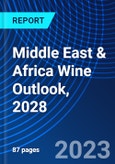This report comes with 10% free customization, enabling you to add data that meets your specific business needs.
1h Free Analyst TimeSpeak directly to the analyst to clarify any post sales queries you may have.
According to the research report Middle East & Africa Wine Market Outlook, 2028, The market is projected to reach market size more than USD 24.62 Billion by 2028. The Middle East is considered the birthplace of winemaking. The oldest known winery, dating back to around 6,000 BC, was discovered in Areni-1 cave in Armenia. This region has a long history of viticulture and winemaking techniques passed down through generations. South Africa's Cape Winelands is one of the most well-known and celebrated wine regions in the world. It boasts stunning landscapes, picturesque vineyards, and a rich winemaking heritage. Other wine regions in the Middle East and Africa include Bekaa Valley in Lebanon, Stellenbosch in South Africa, and the Mendoza region in Morocco. The Middle East and Africa region is home to several unique and indigenous grape varieties that contribute to the diversity of its wines. For instance, South Africa has Pinotage, a red grape variety created in the country. Additionally, Lebanon is known for its native grape variety called Obeidi, used in the production of white wines. Many countries in the Middle East have predominantly Muslim populations, and Islam prohibits the consumption of alcohol. However, some countries have non-Muslim populations, expatriate communities, or tourist areas where alcohol consumption is permitted, leading to the emergence of niche wine markets in those regions. Due to climate challenges, limited grape cultivation areas, and nascent wine industries in some countries, the Middle East and Africa region relies heavily on wine imports. Countries like the United Arab Emirates, Saudi Arabia, and Nigeria are significant importers of wine. Expatriate communities and tourists play a crucial role in driving wine consumption in these markets. Wine tourism is gaining popularity in the Middle East and Africa, offering visitors unique experiences. Wine estates, vineyard tours, and wine festivals attract tourists looking to explore the local wine culture, enjoy scenic landscapes, and indulge in wine tasting experiences. This trend contributes to the development of local economies and promotes the region's wine offerings.
South Africa is renowned for its diverse wine offerings and is considered a leading wine producer in the region. The country specializes in a wide range of varietals, including Chenin Blanc (locally known as Steen), Pinotage (a unique South African grape variety), Sauvignon Blanc, Cabernet Sauvignon, and Shiraz. South Africa's Cape Winelands, particularly the Stellenbosch, Franschhoek, and Constantia regions, are known for producing premium wines. Sparkling wine is gaining popularity in the Middle East and Africa. Countries like South Africa, Morocco, and Tunisia are producing quality sparkling wines, often made using traditional methods. This trend reflects changing consumer preferences and an increasing interest in celebratory and festive wines. Morocco is experiencing a wine renaissance, with a resurgence in its wine industry. The country's unique climate, with hot days and cool nights, combined with the influence of the Atlas Mountains, creates favorable conditions for grape cultivation. Moroccan wines are gaining recognition for their quality, particularly those produced in the Meknes and Essaouira regions. In the Middle East, particularly in countries with Muslim-majority populations, winemakers often pay attention to religious sensitivities. Some wine producers avoid using religious symbols on their labels, opting for more neutral designs or focusing on the geographical origins and grape varietals instead.
Wine festivals and cultural events centered around wine are becoming increasingly popular in the Middle East and Africa. These events showcase local wines, provide opportunities for tasting and education, and celebrate the region's winemaking heritage. Such as the Cape Winelands' Stellenbosch Wine Festival in South Africa and the Wine & Olive Festival in Marrakech, Morocco. Despite the challenges posed by conflict and political instability in certain areas, some winemakers in the Middle East and Africa continue to produce wine under difficult circumstances. For example, wineries in Lebanon's Bekaa Valley have operated throughout periods of unrest, demonstrating resilience and commitment to their craft. In some regions of the Middle East and Africa, winemakers embrace traditional winemaking methods, including the use of indigenous yeasts for fermentation. This approach adds unique flavors and characteristics to the wines, reflecting the local terroir and preserving cultural traditions. Given the prevalence of Muslim populations and cultural norms, the market for non-alcoholic wine alternatives, such as grape juice or alcohol-free wine, is growing in the Middle East. These products provide options for consumers who prefer to avoid alcohol while still enjoying the flavors and experience associated with wine.
Considered in this report
- Geography: Middle East and Africa
- Historic year: 2017
- Base year: 2022
- Estimated year: 2023
- Forecast year: 2028
Aspects covered in this report
- Middle East and Africa Wine Market with its value and forecast along with its segments
- Country-wise Personal Protective Equipment market analysis
- Various drivers and challenges
- On-going trends and developments
- Top profiled companies
- Strategic recommendation
Countries covered in the report:
- United Arab Emirates
- Saudi Arabia
- South Africa
By Product type
- Still Wine
- Sparkling Wine
By Color
- Red Wine
- White Wine
- Rose Wine
- Others
By Sweetness Level
- Semi-Sweet
- Dry
- Sweet
- Semi-Dry
By Distribution Channel
- On Trade
- Off Trade








